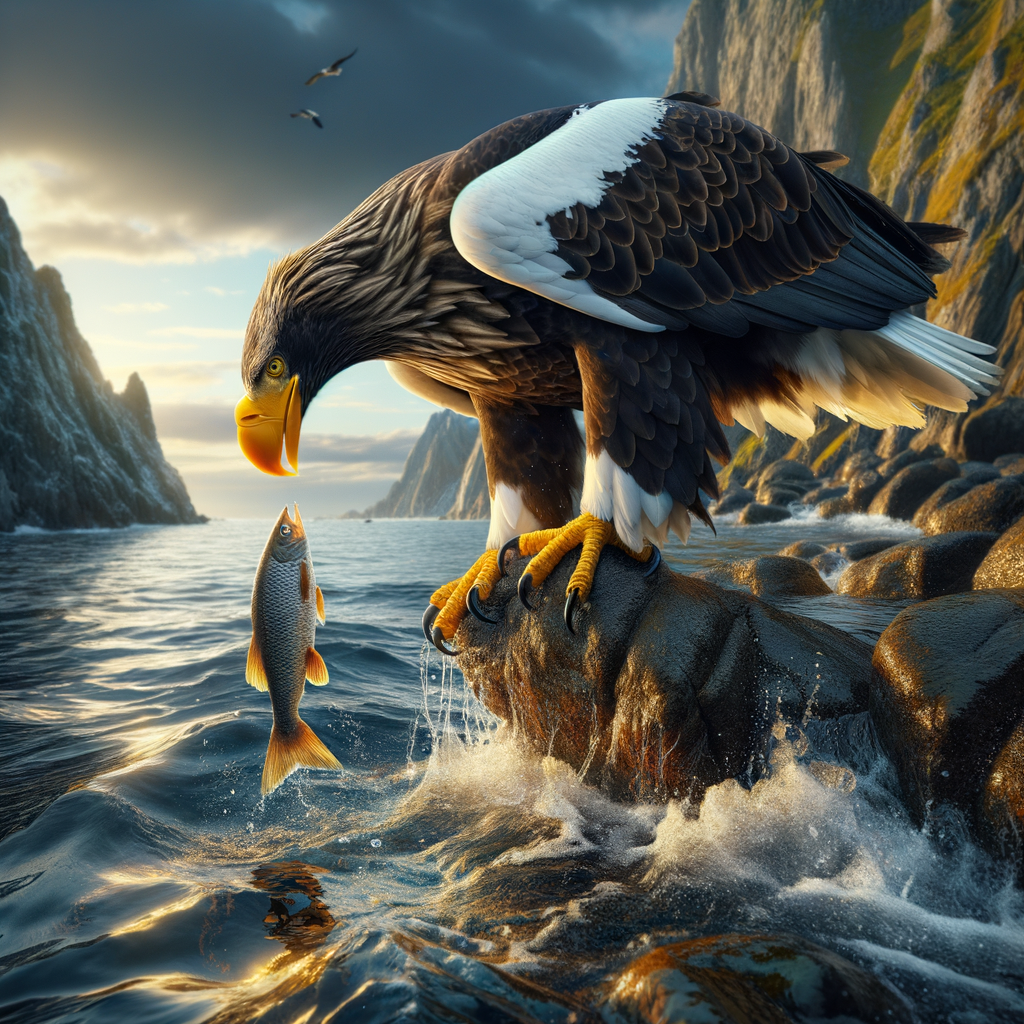Discover the Fascinating World of Steller’s Sea Eagles with Learn Falconry
- Steller’s Sea Eagles are one of the largest and most powerful raptors.
- These majestic birds have striking black and white plumage.
- They are native to coastal areas, particularly in Russia and Japan.
- Steller’s Sea Eagles primarily feed on fish, but they also eat seabirds and small mammals.
- They have incredibly strong talons and beaks to catch and eat their prey.
- These eagles are known for their impressive wingspan, which can reach up to 2.5 meters (8 feet).
- Steller’s Sea Eagles build large nests in tall trees or cliff edges near water.
- They are considered vulnerable due to habitat loss, climate change, and human disturbance.
- Conservation efforts are essential to protect these magnificent birds.
Explore more about these incredible raptors with Learn Falconry!
Discovering the Mighty Steller’s Sea Eagles: Why They Deserve Your Attention
Top of the mornin’ to ya! Imagine you’re on a breathtaking journey through the lush, green hills of Ireland, known for its rolling landscapes and magnificent creatures. Now, let’s swap those familiar clovers for something just as astonishing but from the opposite side of the world’the mighty Steller’s Sea Eagles.
At Learn Falconry, we believe that an encounter with these awe-inspiring birds is like discovering a hidden gem in the heart of an Irish glen. Much like how the legend of the Leprechaun captivates anyone who hears it, the mystery and grandeur of the Steller’s Sea Eagle will leave you spellbound. These birds are not just any eagles; they are mammoths of the avian world, with wingspans stretching up to an impressive 8 feet! Their strength and beauty are truly something to behold.
But don’t just take our word for it. Keep reading and dive deeper into what makes these eagles so extraordinary. From their striking appearance to their important role in the ecosystem, there’s more to these incredible creatures than meets the eye. So grab your reading glasses and get ready to enter a world as fascinating as an Irish folklore tale. You won’t want to miss this!
Discovering the Majestic Steller’s Sea Eagle: A Journey into Falconry
The steller’s sea eagle is one of the most impressive eagle species in the world, known for its striking appearance and formidable presence. This eagle, with its distinctive black and white feathers and bright yellow beak, can capture the attention of anyone lucky enough to see it in flight.
The Unique Characteristics of the Steller’s Sea Eagle
Belonging to the group of large eagles, the steller’s sea eagle stands out due to its robust build and powerful flying abilities. It is larger than most other eagle species, with a wingspan that can reach up to 2.45 meters! These eagles have strong, curved talons that help them catch their primary prey, which includes fish and sea birds.
Habitat and Distribution
Steller’s sea eagles are mainly found across coastal regions of northeastern Asia, particularly in Russia and Japan. They inhabit areas close to water bodies, such as rivers, lakes, and seashores, where food is abundant. These habitats offer the perfect hunting grounds for these magnificent birds.
Diet and Hunting Techniques
As exceptional hunters, steller’s sea eagles primarily feed on fish, such as salmon and trout. Their sharp eyesight allows them to spot prey from a distance, and their powerful legs and talons are used to snatch and hold onto their catch. Their diet also includes small mammals and other birds, making them versatile predators.
To explore more about different eagle species and their behavioral characteristics, check out Species of Falcons.
Steller’s Sea Eagle Falconry: The Art and Practice
Steller’s sea eagle falconry is a fascinating aspect of the broader tradition of falconry that traces back thousands of years. These impressive birds have been trained by falconers to hunt and perform tasks, showcasing the deep bond between humans and raptors.
Training and Techniques
Training a steller’s sea eagle requires patience, skill, and the right equipment. Falconers use various techniques to condition these birds, including positive reinforcement and specialized lures.
Learn more about training methods in our dedicated sections on Basic Training Techniques and Advanced Training Methods.
Falconry Equipment
Proper falconry equipment is essential to handle these majestic eagles. Essential items include hoods, gloves, leashes, and perches, all designed to ensure the safety and well-being of both the bird and the falconer.
For a comprehensive guide on the necessary gear, visit our page on Falconry Equipment.
Conservation and Ethical Practices
The conservation of steller’s sea eagles is crucial due to their limited range and the threats they face from habitat loss and environmental changes. Ethical falconry practices and conservation efforts help protect these extraordinary birds.
Delve into the intersection of falconry and conservation by reading more at Falconry and Conservation.
Join the Falconry Community
For those passionate about falconry, joining a community of like-minded individuals can provide support and further knowledge. From clubs to famous falconers, there’s much to explore in the communal aspect of this ancient sport.
Discover more about joining falconry clubs and the benefits they offer by visiting Falconry Clubs.
Exploring Steller’s Sea Eagles
Welcome to the exciting world of Steller’s Sea Eagles! These magnificent birds are among the largest raptors in the world and have intriguing characteristics that make them stand out in the bird kingdom. Let’s learn more about them.
Distribution and Migration
Steller’s Sea Eagles are endemic to coastal northeastern Asia. Here are some of the regions they call home:
- Countries: Russia, Korea, Japan, China, Taiwan
When it comes to migration, these eagles exhibit fascinating behaviors:
- Migration Patterns: They typically migrate in groups, flying 100-200 meters apart.
- Seasonal Movement: During winter, you might spot these eagles flying over the northern ocean or perching on sea ice.
Conservation Status
The Steller’s Sea Eagle population, although majestic, is facing a decline. Here are some important numbers and threats:
- Current Population: Approximately 5,000
- Trend: Decreasing
Major Threats:
- Habitat alteration
- Industrial pollution
- Overfishing
- Persecution due to stealing furbearers from trappers
Vagrancy
Steller’s Sea Eagles sometimes stray far from their usual range. An interesting instance of vagrancy is:
- North American Appearance: One individual was documented in North America, notably in:
- Denali National Park, Alaska on August 30, 2020
- Various locations in the lower 48 states, Canada, and Newfoundland
Physical Characteristics
Steller’s Sea Eagles are among the largest raptors. Below are some key characteristics:
| Feature | Description |
|---|---|
| Size | Largest bird in the genus Haliaeetus |
| Weight | Females range between 6.2 to 9.5 kg |
| Adult Appearance | Rich brown with snow-white tail, belly, shoulder patches |
| Juvenile Appearance | Darker, acquire mostly white, wedge-shaped tails in the second year |
Diet and Prey
These birds have a varied diet, primarily consisting of:
- Main Prey: Fish and waterfowl
- Occasional Scavenging: Sika deer carcasses
Habitat Preferences
Steller’s Sea Eagles prefer coastal regions and nearby lakes. Significant areas include:
- Hokkaido: Coastal regions are a common habitat for these eagles.
- Kamchatka: They are often found near lakes close to the coast.
Identification
For identifying Steller’s Sea Eagles:
- Adults: Rich brown overall with distinctive white patterns.
- Juveniles: Darker, transitioning to white, wedge-shaped tails as they mature.
These tidbits about Steller’s Sea Eagles give a peek into the lives of these extraordinary birds. Bring your curiosity and continue exploring to learn more about their remarkable journey through the skies!
The Magnificent Steller’s Sea Eagle: A Final Look
Steller’s Sea Eagles capture our imaginations with their impressive size and striking appearance. Not only are they the largest bird in the genus Haliaeetus, but they are also distinguished by their rich brown coloration, snow-white tail, belly, and shoulder patches. These powerful raptors mainly prey on fish and waterfowl, although they occasionally scavenge on sika deer carcasses.
Their presence is most notable along the coasts of northeastern Asia, particularly in places like Hokkaido and Kamchatka. They migrate in groups, with adults often leaving before the younger birds, and can be seen soaring over oceans or perched on sea ice during winter.
However, the future of Steller’s Sea Eagles is uncertain. With an estimated population of around 5,000 and a decreasing trend, they face numerous threats, including habitat alteration, industrial pollution, overfishing, and persecution. Conservation efforts are crucial to ensure these majestic eagles continue to grace our skies.
In wrapping up, while their numbers may be dwindling, the importance of understanding and protecting these incredible birds remains paramount. By learning more about Steller’s Sea Eagles, we can all contribute to their preservation and celebrate their majestic role in our world’s biodiversity.



